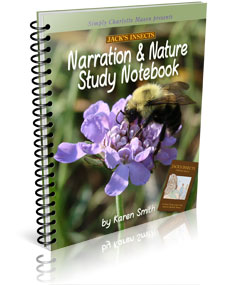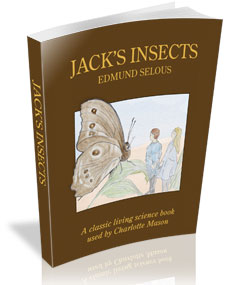Simply Charlotte Mason has reproduced Jack’s Insects, a nature study book by Edmund Selous. This book was written in the early 1900s, and Charlotte Mason used it in her own schools. Simply Charlotte Mason has also published their own book, Jack’s Insects Narration and Nature Study Notebook, to make it easy to use Jack's Insects in homeschool settings. The course should work best with students in grades four through six.
Along with Jack’s Insects and the Narration Notebook, you will need field guides and simple art supplies. Most chapters recommend another resource book specific to the creature being studied—books such as Praying Mantises: Hungry Insect Heroes, Grasshoppers and Crickets of North America, and The Glow-Worm and Other Beetles. You can easily substitute a different book on each topic. A few of the books are listed with website URLs where they should be available for free online.
Following Charlotte Mason’s recommendations, students read about insects, observe them in nature if possible, draw them, and narrate in response to their reading, research, and observations. A few “exam questions” at the back of the book can be used midway through the study and at the end of the study for evaluation.
The book, Jack’s Insects, is a fanciful story of two children named Jack and Maggie who find themselves inside a book about insects. In this fantasy realm, the highly-intelligent and, apparently, well-educated insects converse with the children and lead them on adventures until they finally escape home through a beehive.
Jack’s Insects is best used as a read aloud book. Written for English children, the book has references to numerous people and events from English history at the beginning that might not yet be familiar to your children. You might take time to explain some of those references. Also, some of the vocabulary might be challenging, especially when children encounter the woman who speaks French! (While many English children learned French in the elementary grades at the turn of the twentieth century, few American children do so today.)
The book is amusing, yet the author Edmund Selous, manages to convey a great deal of information about insects through the story line. The 20 chapters of the book each have a corresponding lesson in the Narration Notebook. The book is 290 pages long and the typeface is rather small, which means that there’s quite a bit of content to read. You might want to break up each story into a number of reading sessions.
 After reading a chapter in Jack's Insects, students write narrations in response to questions in the Narration Notebook. In many lessons, they mark on a world map where the particular insects can be found. A section titled “Find Out More” directs students to additional reading or internet research. Space is provided for students to write about what they discovered in their reading and research. A final section for “Nature Study” directs students to look for particular insects in their natural habitats and then draw them. However, if they can’t find them, they can draw from a picture. Drawing pages are included at the back of the Narration Notebook.
After reading a chapter in Jack's Insects, students write narrations in response to questions in the Narration Notebook. In many lessons, they mark on a world map where the particular insects can be found. A section titled “Find Out More” directs students to additional reading or internet research. Space is provided for students to write about what they discovered in their reading and research. A final section for “Nature Study” directs students to look for particular insects in their natural habitats and then draw them. However, if they can’t find them, they can draw from a picture. Drawing pages are included at the back of the Narration Notebook.
Depending upon where you live, finding the insects at the right time for each study might be challenging. You might consider skipping around in the chapters, but that will confuse the storyline of the book. So you really should try to proceed in the given order. However, if you spot one of the upcoming insects ahead of schedule, you might have your children take time to draw it when the opportunity presents itself rather than waiting and hoping it will be there when you need it. You can save the rest of that lesson for later.
I know that many homeschooling parents love Charlotte Mason’s ideas regarding nature study, but they have trouble implementing them in a way that seems academically useful. Jack’s Insects and Jack’s Insects Narration and Nature Study Notebook make it easy to do so. Children learn about the science of entomology while developing observation, research, and writing skills. While this study does require parent participation, it should be enjoyable as a family project.








